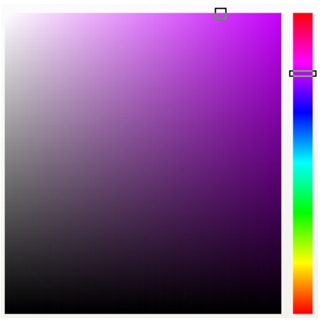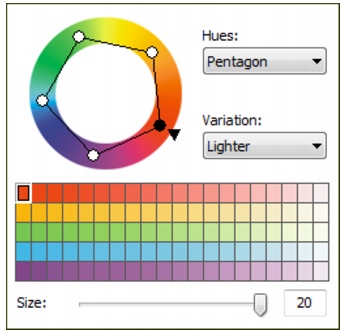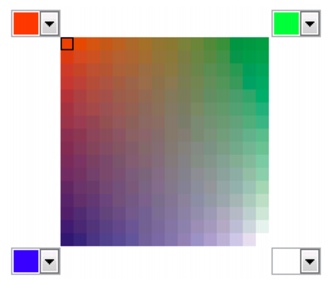Choosing colors
You can choose fill and outline colors by using fixed or custom color palettes, color viewers, color harmonies, or color blends. When you want to use a color that already exists in an object or document, you can sample the color to achieve an exact match.
For information about applying the colors you choose, see “Applying uniform fills” and “Formatting lines and outlines.”
Default color palette
A color palette is a collection of color swatches. In some programs, color palettes are known as “swatch palettes.”
You can choose fill and outline colors by using the default color palette, which contains 99 colors from the CMYK color model.
The selected fill and outline colors appear in the color swatches on the status bar.
Fixed or custom color palettes
Fixed color palettes are provided by third-party manufacturers. Some examples of these are PANTONE, HKS Colors, and TRUMATCH. It may be useful to have on hand a manufacturer’s swatch book, which is a collection of color samples that shows exactly what each color looks like when printed.
Some fixed color palettes — PANTONE, HKS Colors, TOYO, DIC, Focoltone, and SpectraMaster — are collections of spot colors. If you create color separations when you print, each color from these color palettes requires a separate printing plate. This can significantly affect the cost of your print job. If you want to use these colors, but you don’t want to use spot colors, convert the spot colors to process colors when printing. For more information, see “Printing color separations.”
Custom color palettes can include colors from any color model or fixed color palette. You can save a custom color palette for future use. For more information about working with custom color palettes, see “Creating custom color palettes” and “Opening and editing custom color palettes.”

The PANTONE solid coated palette is an example of a fixed color palette.
Sampling colors
When you want to use a color that already exists in a drawing, you can sample the color to achieve an exact match. By default, you sample a single pixel from the drawing window.
Color viewers provide a representation of a range of colors by using either one-dimensional or three-dimensional shapes. The default color viewer is based on the HSB color model, but you can use this viewer to choose CMYK, CMY, or RGB colors. The default color viewer is based on the HSB color model, but you can use this viewer to choose CMY or RGB colors. For information about color models, see “Understanding color models.”

Examples of color viewers
Color harmonies
Color harmonies work by superimposing a shape, such as a rectangle or a triangle, over a color wheel. Each vertical row in the color grid begins with the color located at one of the points on the superimposed shape.
The colors at each corner of the shape are always complementary, contrasting, or harmonious, depending on the shape you choose. The color harmonies let you choose a color model, and they are most useful when you need to choose several colors for a project.

Examples of color harmonies
Color blends
When you choose a color by using color blends, you combine base colors to produce the color you want. The color blender displays a grid of colors that it creates from the four base colors you choose.

Examples of color blends
To choose a color by using the default color palette |
![]()
|
•
|
|
You can display color names by pointing to a swatch.
|

A pop-up color palette
To choose a color by using a fixed or custom color palette |
|
1.
|
|
Select an object.
|
|
4.
|
|
Choose a fixed or custom palette from the Palette list box.
|
![]()
|
•
|
|
Each color swatch on a fixed color palette is marked with a small white square.
|
|
•
|
|
You should use the same color model for all colors in a drawing; the colors will be consistent and you will be able to predict the colors of the final output more accurately. It is preferable to use the same color model that you are using for the final output. For more information about reproducing colors accurately, see “Managing color for display, input, and output.”
|
![]()
|
•
|
|
You can swap the Old color (of the selected object) and the New color (which has been chosen in the color selection area) by clicking Options
|
To choose a color by using a color viewer |
|
1.
|
|
Select an object.
|
|
4.
|
|
Choose a color model from the Model list box.
|
![]()
|
•
|
|
If you choose a color that is out of the printer’s gamut, CorelDRAW displays the closest in-gamut color. This color is displayed in the Reference area, in the small swatch beside the New color. You can either choose this closest in-gamut color or you can correct the out-of-gamut color. For information about color correction, see “Managing color for display, input, and output.”
|
![]()
|
•
|
|
You can swap the Old color (of the selected object) and the New color (which has been chosen in the color selection area) by clicking Options
|
To choose a color by using color harmonies |
|
1.
|
|
Select an object.
|
|
8.
|
|
Click a color swatch on the color palette below the color wheel.
|
![]()
|
•
|
|
If you choose a color that is out of the printer’s gamut, CorelDRAW displays the closest in-gamut color. This color is displayed in the Reference area, in the small swatch beside the New color. You can either choose this closest in-gamut color, or you can correct the out-of-gamut color. For information about color correction, see “Managing color for display, input, and output.”
|
![]()
|
•
|
|
You can swap the Old color (of the selected object) and the New color (which has been chosen in the color selection area) by clicking Options
|
To choose a color by using color blends |
|
1.
|
|
Select an object.
|
![]()
|
•
|
|
Only colors that are on the default color palette can be blended. To blend other colors, you must change the default color palette. For more information, see “To open a custom color palette.”
|
![]()
|
•
|
|
You can swap the Old color (of the selected object) and the New color (which has been chosen in the color selection area) by clicking Options
|
To sample a color |
|
•
|
2×2 — lets you choose the average color in a sample area of 2 × 2 pixels. The pixel you click is in the middle of the sample area.
|
![]()
|
•
|
|
In some cases, the sampled color may be an RGB or CMYK color that is the closest equivalent to the original color, instead of being a complete match.
|
![]()